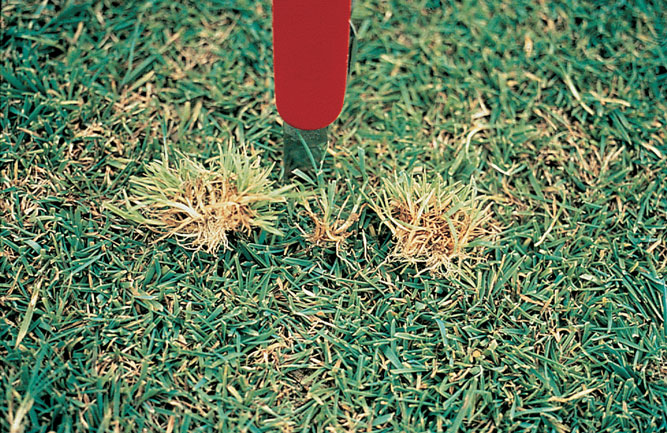How superintendents can prevent and control yellow tuft
Although yellow tuft is a relatively minor turfgrass disease, superintendents must focus on doing everything they can to control it, as a majority of turfgrasses are susceptible to the pathogen.

Consistent fungicide applications are key to both the prevention and control of yellow tuft on golf courses. (Photo: Syngenta)
After all, it tends to have a wide host range, according to Jim Kerns, Ph.D., professor and extension specialist, turfgrass pathology at North Carolina State University.
Typically prevalent during the spring and autumn, as it’s the most active whenever temperatures are more moderate, yellow tuft usually develops in poorly drained areas first — areas that superintendents should especially dedicate their treatment initiatives to.
“Also known as downy mildew, yellow tuft is related to the Pythium species, which requires water, in order to grow and infect turf,” Kerns says. “If the course has particularly wet areas, they should strive to minimize them as much as possible.”
If they’re unable to diminish wet areas enough to prevent the growth of yellow tuft to begin with, Kerns says superintendents shouldn’t be overly stressed about it, as infected plants rarely die. In other words, prevention isn’t critical.

Jim Kerns
“Since yellow tuft is a biotroph, it can’t grow and reproduce without its host,” he states. “So, while it does cause symptoms, it doesn’t actively kill cells in order to feed.”
That doesn’t mean superintendents shouldn’t do everything they can to either treat the pathogen or prevent it outright. To do so, Kerns advises applications of a curative product like mefenoxam as soon as they notice symptoms. Generally, one or two applications are sufficient.
To achieve prevention outright — before any symptoms are noticeable — Kerns recommends superintendents to utilize a phosphite material consistently.
“They should apply phosphite materials every two to three weeks throughout the growing season,” he emphasizes. “In addition, they should address their courses’ drainage issues as quickly as they can by adding drain tiles and lines, while also engaging in a drainage master plan.”

Bret Corbett
Albaugh Specialty Products
Bret Corbett
Product Development Manager, Specialty Products
The best management practice, regarding any turf diseases, is to maintain healthy turf and eliminate problematic areas on the course. Yellow tuft, caused by a water mold fungus, known as Sclerophthora macrospora, is most common on cool-season putting greens, particularly in areas with poorly draining soils. With this in mind, to reduce disease pressure, consider implementing cultural preventive methods like regular aeration, dethatching, overirrigation avoidance and proper drainage installation. If prevention of yellow tuft isn’t possible, there are several active ingredients that can provide control. With regard to all turf diseases, preventative fungicide applications are often more successful than curative. For curative control, superintendents should consider applying mefenoxam, metalaxyl and fosetyl-Al on yellow tuft.

Lisa Beirn, Ph.D.
Syngenta
Lisa Beirn, Ph.D.
Technical Manager
Although yellow tuft can be found in a majority of turfgrass species, it’s most frequently found on annual bluegrass and creeping bentgrass putting greens. Symptoms begin as stunted growth and thickened leaf blades. As the disease progresses, small (less than one inch), yellow patches become evident in the turf. These patches contain groups of plants with excessive tillers, which superintendents can easily remove from their turf. In St. Augustinegrass, symptoms appear as white streaks, parallel to the leaf veins, instead.
The pathogen produces swimming spores that infect seedlings and stem buds during rainy periods in the spring and fall. Because water is necessary for spore movement, yellow tuft is commonly seen in wet, low-lying areas. To help prevent yellow tuft, air circulation must be adequate, and superintendents should drain areas if they have a history of the disease. Fungicides containing mefenoxam can be effective too — if superintendents apply them preventatively. If tufted plants interfere with ball roll, vertical cutting can physically detach them as well.

Jesse Benelli, Ph.D.
Envu
Jesse Benelli, Ph.D.
Green Solutions Team Specialist
Yellow tuft’s symptoms include stunted growth, leaf swelling and excessive tillering from the crown, which is more yellow in color, compared to the surrounding turf. Typically, symptoms are most often observed on turf that’s mowed at a low height in poorly draining sites.
The best long-term control strategy is to improve surface drainage. Another best management practice is to conduct routine irrigation audits, to ensure the uniform distribution of water onto the surface — without too much overlap from multiple sprinkler heads. Superintendents can also physically remove any ‘tufted’ plants with their hands or knives. However, in severe infestations, this may not be practical.
Fungicide applications can work well if superintendents use them preventively. Generally, most fungicides (which have strong activity on Pythium) will also provide adequate control of yellow tuft. Unfortunately, curative applications of fungicides will not provide much value if tufted plants, which have excessive tillering, are already present.

Bobby Kerr, Ph.D.
Quali-Pro
Bobby Kerr, Ph.D.
Technical Service Manager
Yellow tuft is a disease that’s most commonly found on annual bluegrass and creeping bentgrass greens. Nonetheless, it can occur on all turfgrass species, especially when weather conditions are cool and wet. Preventative control is the best management method, as yellow tuft is challenging to control curatively. Superintendents should consider both mefenoxam and fosetyl-A1 for control.
Apply mefenoxam as preventative treatment at a rate of 0.49 to 0.98 fl. oz. in one to 5 gallons of water, per 1,000 ft. sq., at a 10- to 21-day interval. During periods of prolonged conditions that are favorable for disease development, they should use 0.49 to 0.98 fl. oz. at a 14-day interval instead.
For fosetyl-Al, as a preventative treatment, apply at a rate of 4 fl. oz. in one to 5 gallons of water, per 1,000 square feet, at a 14-day interval — or at a rate of 8 fl. oz. in one to 5 gallons of water, per 1,000 ft. sq., at a 21-day interval for success.











